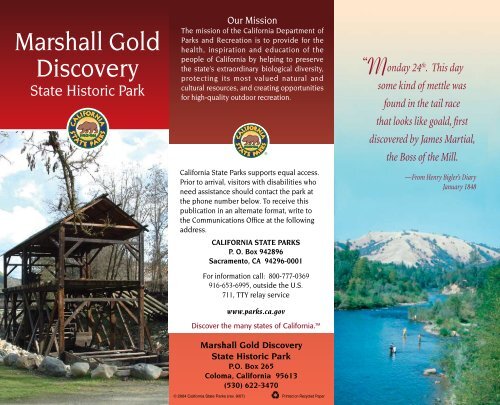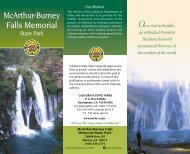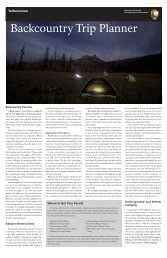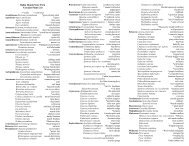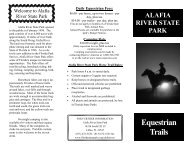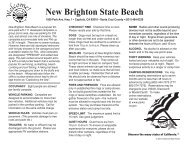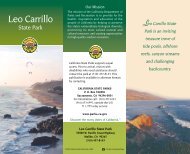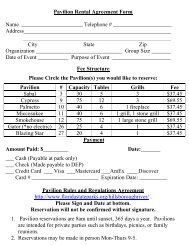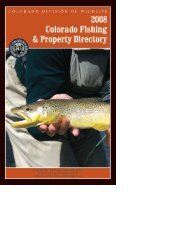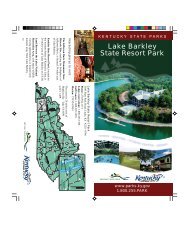Create successful ePaper yourself
Turn your PDF publications into a flip-book with our unique Google optimized e-Paper software.
Marshall Gold<br />
Discovery<br />
State Historic <strong>Park</strong><br />
Our Mission<br />
The mission of the California Department of<br />
<strong>Park</strong>s and Recreation is to provide for the<br />
health, inspiration and education of the<br />
people of California by helping to preserve<br />
the state’s extraordinary biological diversity,<br />
protecting its most valued natural and<br />
cultural resources, and creating opportunities<br />
for high-quality outdoor recreation.<br />
California State <strong>Park</strong>s supports equal access.<br />
Prior to arrival, visitors with disabilities who<br />
need assistance should contact the park at<br />
the phone number below. To receive this<br />
publication in an alternate format, write to<br />
the Communications Office at the following<br />
address.<br />
CALIFORNIA STATE PARKS<br />
P. O. Box 942896<br />
Sacramento, CA 94296-0001<br />
For information call: 800-777-0369<br />
916-653-6995, outside the U.S.<br />
711, TTY relay service<br />
www.parks.ca.gov<br />
Discover the many states of California.<br />
Marshall Gold Discovery<br />
State Historic <strong>Park</strong><br />
P.O. Box 265<br />
Coloma, California 95613<br />
(530) 622-3470<br />
© 2004 California State <strong>Park</strong>s (rev. 9/07) Printed on Recycled Paper<br />
“M<br />
onday 24 th . This day<br />
some kind of mettle was<br />
found in the tail race<br />
that looks like goald, first<br />
discovered by James Martial,<br />
the Boss of the Mill.<br />
”<br />
—From Henry Bigler’s Diary<br />
January 1848
Along California’s<br />
historic Highway 49,<br />
tucked neatly into a beautifully<br />
forested valley in the Sierra<br />
foothills, Marshall Gold<br />
Discovery State Historic <strong>Park</strong><br />
straddles the South Fork of<br />
the American River. Here,<br />
on January 24, 1848, James<br />
Marshall found some gold<br />
flakes in the streambed and<br />
sparked one of history’s<br />
largest human migrations.<br />
PARK HISTORY<br />
Native People<br />
For thousands of years, the Nisenan<br />
and foothill Miwok people built their<br />
dome-shaped houses in villages along<br />
the streams and tributaries that drained<br />
the American, Cosumnes, Bear and Yuba<br />
Rivers. They called their home along<br />
the American River “Cullumah,”<br />
Watercolor of an Eastern Miwok<br />
woman fashioning a seed gathering<br />
basket by Seth Eastman<br />
The Marshall Monument<br />
Artwork courtesy of W. Duncan and Nevin<br />
MacMillan, and Afton Historical Society Press<br />
now known as Coloma. Prior to<br />
foreign intrusion, they lived on a<br />
diet of animals, acorns, seeds and<br />
fruits. The hollowed out holes in a<br />
large bedrock in the park—the last<br />
remaining evidence of the native<br />
people’s presence here—show<br />
how they processed the acorns that<br />
formed their main diet. As “river<br />
people” they enjoyed an abundance<br />
of freshwater fish as well as waterfowl,<br />
elk, deer and small game.<br />
Until they met fur trappers in the<br />
late 1820s, the native people had little contact<br />
with the outside world. However, by the late<br />
1830s, diseases introduced by the newcomers<br />
nearly decimated them. When gold was<br />
discovered along the American River in the<br />
Coloma Valley, hordes of gold-seekers seized<br />
control of the California Indians’ fishing and<br />
gathering sites. By 1849 the<br />
remaining native people who<br />
had survived the combined<br />
hardships of disease and<br />
conflicts with settlers had<br />
dispersed to more remote<br />
areas of the Gold Country. A<br />
few turned to mining, and a<br />
few worked for John Sutter.<br />
Photo courtesy of California<br />
State Library, Sacramento, California<br />
January 24, 1848—<br />
THE GOLD DISCOVERY<br />
John Sutter was founder<br />
of “New Helvetia,”—<br />
later named Sacramento—and a vast<br />
agricultural empire in the Sacramento<br />
Valley. He partnered with James W.<br />
Marshall to go into the lumber business.<br />
They selected Coloma Valley, 45 miles<br />
east of Sutter’s fort, as a mill site because<br />
it had a river for power and stands of large<br />
ponderosa pine trees for lumber. As equal<br />
partners, Sutter would furnish the capital,<br />
and Marshall would oversee the mill’s<br />
construction and operation.<br />
In the fall of 1847, Marshall began<br />
construction of the mill with a labor force<br />
that included both Indians and members<br />
of the U.S. Army Mormon Battalion. A low<br />
dam was built across the river to funnel<br />
part of the stream into the diversion<br />
channel that would carry it through the<br />
mill. By January of the next year, the mill<br />
was ready to be tested. However, the<br />
tailrace, which carried water away from the<br />
mill, was too shallow, backing up water<br />
and preventing the mill wheel from turning<br />
properly. To deepen the tailrace,<br />
each day the Indian laborers<br />
loosened the rock. At night,<br />
water was allowed to run through<br />
the ditch to wash away the loose<br />
debris from that day’s diggings.<br />
On the morning of January<br />
24, 1848, while inspecting the<br />
watercourse, Marshall spotted<br />
some shiny flecks in the tailrace.<br />
He scooped them up, and after<br />
John A. Sutter<br />
bending them with his fingernail<br />
and pounding them with a rock,<br />
he placed them in the crown of his hat<br />
and hurried to announce his find to<br />
the others. He told the mill workers,
ill, c.<br />
1849<br />
“Boys, by God, I believe<br />
I’ve found a gold mine.”<br />
When Mr. Scott—a<br />
carpenter working on the<br />
mill wheel—disputed his<br />
claim, Marshall replied<br />
positively, “I know it to be<br />
nothing else.” Marshall<br />
pounded it on a rock, and<br />
the cook, Jenny Wimmer,<br />
boiled it in lye soap. It<br />
passed all their tests—it<br />
was pure gold.<br />
Four days later Marshall<br />
rode to the fort with<br />
samples of the gold.<br />
Sutter consulted his<br />
encyclopedia, tried various tests, and<br />
confirmed Marshall’s conclusion. Mindful<br />
of their investment in the mill, they agreed<br />
to keep the news secret until the mill<br />
was in operation. After all, this was not<br />
the first time gold had been discovered<br />
in California, and there was no reason<br />
to assume that this find was particularly<br />
important.<br />
But it was a secret that could not be<br />
kept. In a letter to General Mariano<br />
Vallejo, Sutter bragged about the<br />
discovery. Mormon elder Sam Brannan,<br />
who operated a general store at the fort,<br />
went to the mill to see for himself. Several<br />
Mormon mill workers readily gave him a<br />
tithe of the gold they had found. When<br />
Brannan visited San Francisco in May,<br />
he paraded the streets waving a quinine<br />
bottle full of gold, shouting, “Gold! Gold!<br />
Early drawing of Sutter’s Mill, c. 1849<br />
Photo by Betty Sederquist<br />
Gold from the American<br />
River!” By the end of May,<br />
San Francisco was reported<br />
to be “half empty” as the<br />
able-bodied men departed<br />
for the mines. The excitement<br />
grew when an army officer<br />
carried a tea caddy full of gold<br />
to Washington, D.C. Shortly<br />
after President James K.<br />
Polk confirmed the rumors,<br />
thousands came to join the<br />
trek to the Gold Country.<br />
Chinese Immigrants<br />
News of the gold discovery<br />
spread throughout the world.<br />
In China, California was called<br />
Gum San—“Gold Mountain.” Chinese workers,<br />
lured to California by a promised golden<br />
mountain from which they could literally carve<br />
out their fortune, were fleeing years of war and<br />
poverty. Chinese miners at Coloma—thought<br />
to have numbered about 50—were so efficient<br />
at finding gold that other miners complained<br />
of a “Chinese invasion.” Hostilities among<br />
the miners helped spark discriminatory<br />
taxes and laws enforced only against<br />
“foreign” miners.<br />
The easy-to-find placer gold at Coloma<br />
played out early. By 1857 many miners had<br />
left, but a few Chinese miners remained<br />
to work the played-out placer sites. Two<br />
structures used by the Chinese remain in<br />
the park today—the Man Lee building,<br />
which housed a Chinese trading and<br />
banking company as well as a hardware<br />
store, and the Wa Hop Store, once leased<br />
to a Chinese merchant of that name.<br />
They currently house exhibits of gold<br />
mining techniques and the mercantile<br />
goods needed by the Chinese miners.<br />
The Wah Hop building—<br />
a Gold Rush-era Chinese store<br />
Living history program at the park’s 49er Family Festival
African American<br />
Settlers<br />
According to the Gooch-<br />
Monroe family’s oral history,<br />
Peter and Nancy Gooch<br />
came to Coloma as slaves<br />
in 1849. The following year<br />
California became a free<br />
state. Peter Gooch worked<br />
in construction and at<br />
odd jobs, and Nancy did<br />
domestic chores for the<br />
miners. By 1861 Nancy<br />
had saved enough money<br />
to buy the freedom of her<br />
son, Andrew Monroe, who<br />
was still a slave in Missouri.<br />
Andrew brought his wife, Sarah, and their<br />
three children to Coloma, where they became<br />
respected farmers. In the 1940s the State<br />
purchased some of the Monroe landholdings<br />
from Andrew Monroe’s son, Pearley, which<br />
included the original site of Sutter’s Mill and the<br />
site of Marshall’s gold discovery—the foundation<br />
of today’s park. The entire Gooch-Monroe family<br />
are buried in the park’s Pioneer Cemetery.<br />
Coloma, Queen of the Mines<br />
In the wake of the hopeful gold seekers<br />
came merchants, doctors, lawyers, gamblers,<br />
ministers—all the services required to supply a<br />
miner and relieve him of his burdensome gold<br />
dust. From Coloma the miners moved up the<br />
canyons and into the mountains. With each new<br />
strike, and as the placer gold gave out, Coloma<br />
declined in population. By1857 the El Dorado<br />
County seat had been transferred to nearby<br />
Placerville. By then the Chinese were almost<br />
The Monroe family: William, Grant, Pearley,<br />
Andrew Jr. (top); Cordelia, James, Andrew<br />
Sr., Sarah (middle); Garfield (bottom)<br />
the only miners working the<br />
gravel bars near the discovery<br />
site, and Coloma again became<br />
a peaceful community, with<br />
agriculture and transportation<br />
its economic base.<br />
The Discoverer<br />
In the late 1830s, New<br />
Jersey native James<br />
Marshall traveled<br />
west to Missouri,<br />
where he worked<br />
as a carpenter and<br />
farmed along the<br />
Missouri River. When<br />
his doctor advised<br />
him to seek a healthier<br />
climate, Marshall joined a wagon<br />
train bound for Oregon in 1844, James Wilson Marshall<br />
and in June 1845 he headed for<br />
as sketched in 1849<br />
California with a small party of settlers.<br />
He arrived at Sutter’s fort in July and was<br />
immediately hired as a wheelwright and<br />
carpenter. Craftsmen with his experience<br />
were scarce in California. Marshall purchased<br />
a ranch on Butte Creek, but after fighting<br />
alongside the Americans during their conquest<br />
of California in 1846, he returned home to<br />
discover his cattle strayed or stolen. He met<br />
again with John Sutter, who gave him the task<br />
of finding a site to build their new sawmill.<br />
With the gold discovery, the sawmill at<br />
Coloma quickly lost its sleepy, peaceful<br />
aspect. In July 1848 Colonel Richard B. Mason<br />
visited the mill site and estimated the area’s<br />
population at 4,000. By December 1848,<br />
flooding caused Sutter to sell his interest in<br />
the mill, and Marshall took on two new<br />
partners. Later, management problems<br />
entangled the mill in legal difficulties, and<br />
after 1850 it was abandoned. Marshall<br />
spent the next few years searching for<br />
gold, with little success. In 1857 he bought<br />
fifteen acres of land in Coloma for $15 and<br />
built a cabin near the Catholic church.<br />
Investing in new and exotic varieties<br />
of grapevines, he planted a vineyard<br />
on the hillside above the cemetery,<br />
dug a cellar, and began to make<br />
wine for sale. By 1860 his vines<br />
were doing so well that his entry in<br />
the county fair received an award,<br />
but in the late 1860s, a series of<br />
setbacks sent him prospecting<br />
again. During this time Marshall<br />
became part owner of a quartz mine<br />
near Kelsey. Hoping to raise funds<br />
to develop the mine, he went on a<br />
lecture tour, only to find himself stranded<br />
“A frenzy had<br />
seized my soul...<br />
piles of gold rose<br />
up before me at<br />
every step; castles<br />
of marbel…<br />
thousands of<br />
slaves…myriads<br />
of fair virgins...<br />
the Rothschilds,<br />
Girards, and<br />
Astors appeared<br />
to me but poor people.”<br />
Diary of J. H. Carson, 1852
penniless in<br />
Kansas City. In<br />
a philanthropic<br />
gesture, Leland<br />
Stanford paid<br />
Marshall’s fare<br />
to New Jersey<br />
where he visited<br />
his mother and<br />
sister. After a<br />
few months,<br />
he returned<br />
to Kelsey and<br />
moved into the<br />
Union Hotel.<br />
In 1872 the<br />
State Legislature passed a bill to provide<br />
Marshall a pension of $200 a month<br />
for two years. He paid some debts and<br />
equipped a blacksmith shop in Kelsey.<br />
The state pension was reduced by half for<br />
the next four years, but it ended in 1878<br />
amid criticism of Marshall’s personal habits—especially<br />
his weakness for liquor.<br />
Marshall continued to work in his<br />
blacksmith shop and in the small gold<br />
mines he owned near Kelsey. When he<br />
died on August 10, 1885, at the age of<br />
75, the man who dug his grave on the<br />
hillside was Andrew Monroe, the son of<br />
Nancy Gooch. In 1890 a monumental<br />
statue—California’s first State Historic<br />
Monument—was commissioned and<br />
placed on the hill overlooking the gold<br />
discovery site to mark the location of<br />
Marshall’s grave.<br />
Photo by Ric Horner<br />
Cemetery and James Marshall’s cabin<br />
What if gold had not been<br />
discovered?<br />
California was a pastoral backwater<br />
and wilderness in 1848. Nine days<br />
after Marshall’s fateful discovery—at<br />
the conclusion of the Mexican-<br />
American War—the United States<br />
had been granted this land as<br />
part of a treaty. Its non-Indian<br />
population was about 14,000. At the<br />
time, only a few hundred overland<br />
pioneers had found ways to bring<br />
their wagon trains across the deserts<br />
and mountains to California. But<br />
that all changed with the discovery<br />
of gold.<br />
Between 1848 and 1852, the world’s fascination<br />
with California caused its non-Indian<br />
population to boom to more than 200,000.<br />
Few “Forty-Niners” intended to remain in<br />
California permanently—most had come to<br />
seek their fortune and then<br />
return home. But many sent<br />
for their families and stayed,<br />
while others returned later to<br />
become permanent residents.<br />
Over the next 50 years,<br />
roughly 125 million ounces of<br />
gold taken from the hills had<br />
a critical effect on California’s<br />
early development. If gold<br />
had not been discovered,<br />
California’s climate, resources<br />
and location might have been<br />
ignored for a much longer<br />
time. There would have been<br />
Photo by Ric Horner<br />
little interest in building a transcontinental<br />
railroad to bind the nation together. More<br />
importantly, without Marshall’s momentous<br />
discovery, a more gradual influx of<br />
“foreigners” from the U.S. might have been<br />
quietly absorbed into California’s Spanish/<br />
Mexican cattle- and agriculture-based<br />
economy. However, James Marshall spotted<br />
a shiny bit of metal in the tailrace at Sutter’s<br />
mill, giving rise to one of the most culturally<br />
diverse and technologically advanced<br />
populations in the world.<br />
The <strong>Park</strong><br />
Marshall Gold Discovery State Historic <strong>Park</strong>,<br />
created in 1942, encompasses most of the<br />
historic town of Coloma. With about two<br />
hundred year-round residents in town and<br />
the surrounding area, the tree-lined streets<br />
of the park are usually quiet, shady and<br />
serene. Most visitors and students come<br />
during spring, summer and<br />
fall or for special events yearround,<br />
including the annual<br />
celebration of the January 24<br />
gold discovery.<br />
A number of historic<br />
buildings and sites—including<br />
the blacksmith shop, the Price-<br />
Thomas and Papini homes, the<br />
Mormon, James Marshall, and<br />
Miner’s cabins, and the Indian<br />
bedrock mortar—remain to<br />
remind us of that tumultuous<br />
period. One outstanding<br />
attraction of the park is the fullsized<br />
replica of Sutter’s sawmill.<br />
1858 St. John’s Church
The original, abandoned and torn down for<br />
its lumber, disappeared in the floods of<br />
the 1850s. The replica, looking much like<br />
the original, was completed in 1968 and is<br />
interpreted for park visitors. Some of the<br />
original mill’s timbers, reclaimed from the<br />
river, are displayed nearby. Gold-panning<br />
activities are available year-round.<br />
The Gold Discovery Museum and<br />
Other Exhibits<br />
Exhibits in the Gold Discovery Museum tell<br />
the story of John Sutter and James Marshall,<br />
and how drastically the simple act of<br />
noticing a small fleck of gold would alter the<br />
lives of hundreds of thousands of people<br />
from that day to the present. The museum<br />
also has Indian and Gold Rush-era exhibits,<br />
including mining equipment, horse-drawn<br />
vehicles, household implements and other<br />
memorabilia, as well as films about the gold<br />
discovery and early mining techniques.<br />
Next door to the museum are an outdoor<br />
mining exhibit and two original buildings<br />
used by the Chinese. Throughout the park,<br />
the exhibits show the various standards<br />
of living as Coloma developed through<br />
time. The Gold Discovery Loop Trail<br />
makes it easy to visit the site of Marshall’s<br />
momentous discovery, the original mill site,<br />
as well as other points of interest.<br />
You can walk under native Californian<br />
trees, as well as the Chinese Tree of Heaven,<br />
black locust, Texas mesquite, southern<br />
pecan, Osage orange, persimmon and others<br />
planted by homesick miners as reminders<br />
of their former dwellings.<br />
Accessible Features<br />
Hiking<br />
The half-mile Gold Discovery Loop Trail,<br />
from the museum to the gold discovery<br />
overlook site, is mostly level and hard packed,<br />
but some slopes may require assistance.<br />
Picnicking<br />
The North Beach group picnic area has<br />
accessible tables with generally accessible<br />
restrooms and parking nearby. The picnic<br />
area near the Wah Hop Store and Mann Lee<br />
exhibits has accessible tables that may be<br />
usable with assistance.<br />
Please Remember<br />
• The museum and historic buildings are<br />
open from 10:00 a.m. to 3:00 p.m. daily,<br />
and may be open longer depending on<br />
availability of staff. They are closed on<br />
Thanksgiving, Christmas and New Year’s<br />
days. <strong>Park</strong> grounds are open daily, 8:00<br />
a.m. to sunset.<br />
• Check the current schedule for<br />
interpretive programs at the<br />
museum/visitor center, or<br />
visit the park’s website.<br />
• Call the park to arrange to<br />
have your wedding in either<br />
of the park’s historic churches<br />
or on the park’s grounds.<br />
• There is no camping in<br />
the park, but the Coloma<br />
and Lotus communities<br />
have several private campgrounds<br />
and stores. Recreational<br />
gold panning, with<br />
hands and pan only, is allowed<br />
in designated areas.<br />
Exhibits<br />
The accessibly-designed Gold Discovery<br />
Museum has restrooms, self-guided<br />
exhibits and an audio-visual theater. Video<br />
captioning and large print brochures are<br />
available.<br />
Accessibility is continually improving.<br />
For current details, call the park, or visit<br />
http://access.parks.ca.gov.<br />
• Help keep the park clean. Whatever<br />
you bring in, please take out with you.<br />
• Stay on the trails—shortcuts destroy<br />
ground cover and speed erosion.<br />
The river shoreline has submerged<br />
obstacles and an uneven bottom, and<br />
the water level and flow change quickly<br />
and often. Diving is not permitted.<br />
• Dogs must be on a leash<br />
and are not permitted<br />
in historic buildings,<br />
on trails, outside of<br />
developed areas, or on<br />
beaches.<br />
• To guarantee access<br />
to the park, groups of<br />
ten or more must make<br />
advance reservations.<br />
For more information<br />
call (866) 240-4655,<br />
or visit our website at<br />
www.parks.ca.gov.
Cooking demonstration<br />
This park is supported in part through a<br />
nonprofit organization. For more information<br />
contact: Gold Discovery <strong>Park</strong> Association<br />
• P.O. Box 461 • Coloma, CA 95613 •<br />
• (530) 622-6198 • www.marshallgold.org


